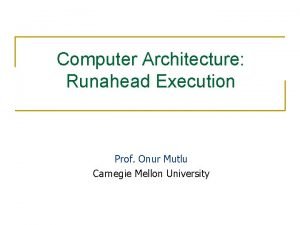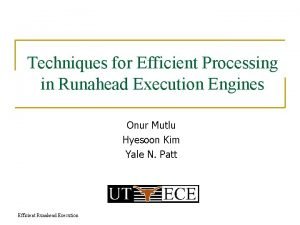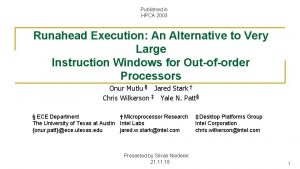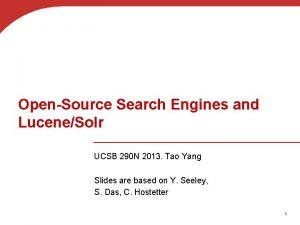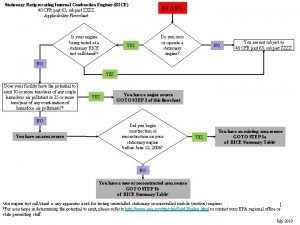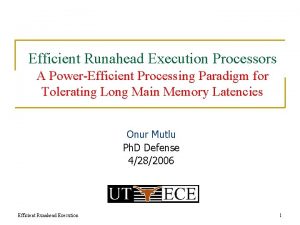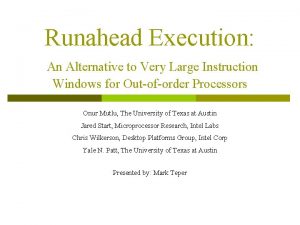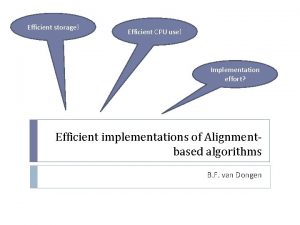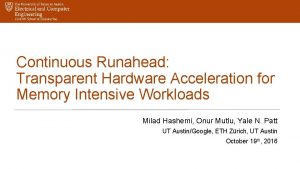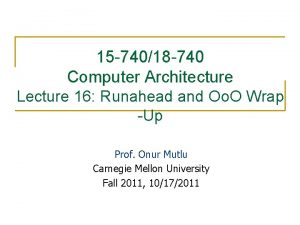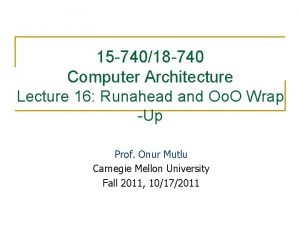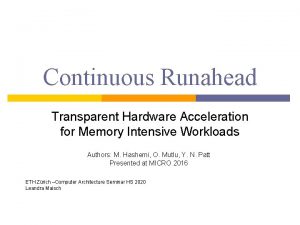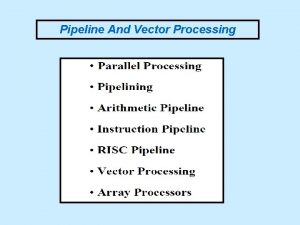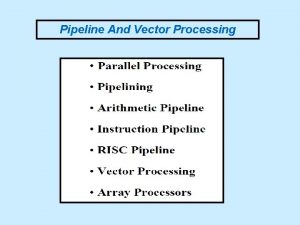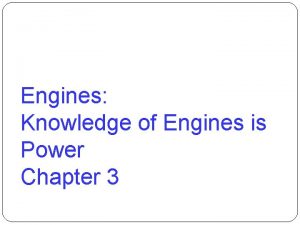Techniques for Efficient Processing in Runahead Execution Engines




































- Slides: 36

Techniques for Efficient Processing in Runahead Execution Engines Onur Mutlu Hyesoon Kim Yale N. Patt Efficient Runahead Execution

Talk Outline n n n n Background on Runahead Execution The Problem Causes of Inefficiency and Eliminating Them Evaluation Performance Optimizations to Increase Efficiency Combined Results Conclusions Efficient Runahead Execution 2

Background on Runahead Execution n n A technique to obtain the memory-level parallelism benefits of a large instruction window When the oldest instruction is an L 2 miss: q n In runahead mode: q q q n Checkpoint architectural state and enter runahead mode Instructions are speculatively pre-executed The purpose of pre-execution is to generate prefetches L 2 -miss dependent instructions are marked INV and dropped Runahead mode ends when the original L 2 miss returns q Checkpoint is restored and normal execution resumes Efficient Runahead Execution 3

Runahead Example Small Window: Load 2 Miss Load 1 Miss Compute Stall Compute Miss 1 Stall Miss 2 Runahead: Load 1 Miss Compute Load 2 Miss Runahead Miss 1 Load 1 Hit Load 2 Hit Compute Saved Cycles Miss 2 Efficient Runahead Execution 4

The Problem n n n A runahead processor pre-executes some instructions speculatively Each pre-executed instruction consumes energy Runahead execution significantly increases the number of executed instructions, sometimes without providing significant performance improvement Efficient Runahead Execution 5

The Problem (cont. ) 22. 6% 26. 5% Efficient Runahead Execution 6

Efficiency of Runahead Execution Efficiency = % Increase in IPC % Increase in Executed Instructions n Goals: q q Reduce the number of executed instructions without reducing the IPC improvement Increase the IPC improvement without increasing the number of executed instructions Efficient Runahead Execution 7

Talk Outline n n n n Background on Runahead Execution The Problem Causes of Inefficiency and Eliminating Them Evaluation Performance Optimizations to Increase Efficiency Combined Results Conclusions Efficient Runahead Execution 8

Causes of Inefficiency n Short runahead periods n Overlapping runahead periods n Useless runahead periods Efficient Runahead Execution 9

Short Runahead Periods n Processor can initiate runahead mode due to an already in-flight L 2 miss generated by q the prefetcher, wrong-path, or a previous runahead period Load 1 Miss Load 2 Miss Load 1 Hit Load 2 Miss Compute Runahead Miss 1 Miss 2 n Short periods q are less likely to generate useful L 2 misses q have high overhead due to the flush penalty at runahead exit Efficient Runahead Execution 10

Eliminating Short Runahead Periods n Mechanism to eliminate short periods: q q q n Record the number of cycles C an L 2 -miss has been in flight If C is greater than a threshold T for an L 2 miss, disable entry into runahead mode due to that miss T can be determined statically (at design time) or dynamically T=400 for a minimum main memory latency of 500 cycles works well Efficient Runahead Execution 11

Overlapping Runahead Periods n Two runahead periods that execute the same instructions Load 1 Miss Load 2 INV Compute Load 1 Hit Load 2 Miss 1 n OVERLAP Runahead Miss 2 Second period is inefficient Efficient Runahead Execution 12

Overlapping Runahead Periods (cont. ) n Overlapping periods are not necessarily useless q The availability of a new data value can result in the generation of useful L 2 misses n But, this does not happen often enough n Mechanism to eliminate overlapping periods: q q q Keep track of the number of pseudo-retired instructions R during a runahead period Keep track of the number of fetched instructions N since the exit from last runahead period If N < R, do not enter runahead mode Efficient Runahead Execution 13

Useless Runahead Periods n Periods that do not result in prefetches for normal mode Load 1 Miss Compute Load 1 Hit Runahead Miss 1 n n They exist due to the lack of memory-level parallelism Mechanism to eliminate useless periods: q q Predict if a period will generate useful L 2 misses Estimate a period to be useful if it generated an L 2 miss that cannot be captured by the instruction window n Useless period predictors are trained based on this estimation Efficient Runahead Execution 14

Predicting Useless Runahead Periods n Prediction based on the past usefulness of runahead periods caused by the same static load instruction q n Prediction based on too many INV loads q n If the fraction of INV loads in a runahead period is greater than T, exit runahead mode Sampling (phase) based prediction q n A 2 -bit state machine records the past usefulness of a load If last N runahead periods generated fewer than T L 2 misses, do not enter runahead for the next M runahead opportunities Compile-time profile-based prediction q If runahead modes caused by a load were not useful in the profiling run, mark it as non-runahead load Efficient Runahead Execution 15

Talk Outline n n n n Background on Runahead Execution The Problem Causes of Inefficiency and Eliminating Them Evaluation Performance Optimizations to Increase Efficiency Combined Results Conclusions Efficient Runahead Execution 16

Baseline Processor n n n n Execution-driven Alpha simulator 8 -wide superscalar processor 128 -entry instruction window, 20 -stage pipeline 64 KB, 4 -way, 2 -cycle L 1 data and instruction caches 1 MB, 32 -way, 10 -cycle unified L 2 cache 500 -cycle minimum main memory latency Aggressive stream-based prefetcher 32 DRAM banks, 32 -byte wide processor-memory bus (4: 1 frequency ratio), 128 outstanding misses q Detailed memory model Efficient Runahead Execution 17

Impact on Efficiency 26. 5%26. 5% 22. 6% 20. 1% 15. 3% 14. 9% 11. 8% 6. 7% Efficient Runahead Execution 18

Performance Optimizations for Efficiency n n Both efficiency AND performance can be increased by increasing the usefulness of runahead periods Three optimizations: q q q Turning off the Floating Point Unit (FPU) in runahead mode Optimizing the update policy of the hardware prefetcher (HWP) in runahead mode Early wake-up of INV instructions (in paper) Efficient Runahead Execution 19

Turning Off the FPU in Runahead Mode n n FP instructions do not contribute to the generation of load addresses FP instructions can be dropped after decode q q n Spares processor resources for more useful instructions Increases performance by enabling faster progress Enables dynamic/static energy savings Results in an unresolvable branch misprediction if a mispredicted branch depends on an FP operation (rare) Overall – increases IPC and reduces executed instructions Efficient Runahead Execution 20

HWP Update Policy in Runahead Mode n n n Aggressive hardware prefetching in runahead mode may hurt performance, if the prefetcher accuracy is low Runahead requests more accurate than prefetcher requests Three policies: q q q n n Do not update the prefetcher state Update the prefetcher state just like in normal mode Only train existing streams, but do not create new streams Runahead mode improves the timeliness of the prefetcher in many benchmarks Only training the existing streams is the best policy Efficient Runahead Execution 21

Talk Outline n n n n Background on Runahead Execution The Problem Causes of Inefficiency and Eliminating Them Evaluation Performance Optimizations to Increase Efficiency Combined Results Conclusions Efficient Runahead Execution 22

Overall Impact on Executed Instructions 26. 5% 6. 2% Efficient Runahead Execution 23

Overall Impact on IPC 22. 6% 22. 1% Efficient Runahead Execution 24

Conclusions n n Three major causes of inefficiency in runahead execution: short, overlapping, and useless runahead periods Simple efficiency techniques can effectively reduce three causes of inefficiency Simple performance optimizations can increase efficiency by increasing the usefulness of runahead periods Proposed techniques: q q reduce the extra instructions from 26. 5% to 6. 2%, without significantly affecting performance are effective for a variety of memory latencies ranging from 100 to 900 cycles Efficient Runahead Execution 25

Backup Slides Efficient Runahead Execution

Baseline IPC Efficient Runahead Execution 27

Memory Latency (Executed Instructions) Efficient Runahead Execution 28

Memory Latency (IPC Delta) Efficient Runahead Execution 29

Cache Sizes (Executed Instructions) Efficient Runahead Execution 30

Cache Sizes (IPC Delta) Efficient Runahead Execution 31

INT (Executed Instructions) Efficient Runahead Execution 32

INT (IPC Delta) Efficient Runahead Execution 33

FP (Executed Instructions) Efficient Runahead Execution 34

FP (IPC Delta) Efficient Runahead Execution 35

Early INV Wake-up n n Keep track of INV status of an instruction in the scheduler. Scheduler wakes up the instruction if any source is INV. + Enables faster progress during runahead mode by removing the useless INV instructions faster. - Increases the number of executed instructions. - Increases the complexity of the scheduling logic. n Not worth implementing due to small IPC gain Efficient Runahead Execution 36
 Runahead execution
Runahead execution Runahead execution
Runahead execution Runahead execution
Runahead execution Productively efficient vs allocatively efficient
Productively efficient vs allocatively efficient Allocative efficiency
Allocative efficiency C b a d
C b a d Allocative efficiency vs productive efficiency
Allocative efficiency vs productive efficiency Productively efficient vs allocatively efficient
Productively efficient vs allocatively efficient Stream processing engines
Stream processing engines Efficient processing of deep neural networks
Efficient processing of deep neural networks Troubleshooting small engines
Troubleshooting small engines Siege engines
Siege engines Gopher search engine history
Gopher search engine history Knowledge search engines
Knowledge search engines Meta search engines compared
Meta search engines compared Open source search engines
Open source search engines Bill nye fuel injector
Bill nye fuel injector Fuel saver plus
Fuel saver plus Engine section
Engine section What is displacement in cars
What is displacement in cars Harper industries has $900 million
Harper industries has $900 million Architecture of a search engine
Architecture of a search engine Other search engines
Other search engines Natural draft carburetor
Natural draft carburetor Information retrieval slides
Information retrieval slides Dot search
Dot search Aircraft engines
Aircraft engines Hz121800
Hz121800 Chapter 5 principles of engine operation
Chapter 5 principles of engine operation Avaya identity engines
Avaya identity engines Sustainable and green engines
Sustainable and green engines Mact zzzz flowchart
Mact zzzz flowchart Race engine technology
Race engine technology Search engines information retrieval in practice
Search engines information retrieval in practice Alliteration in keeping quiet
Alliteration in keeping quiet Automotive engines 8th edition
Automotive engines 8th edition Search engines
Search engines
